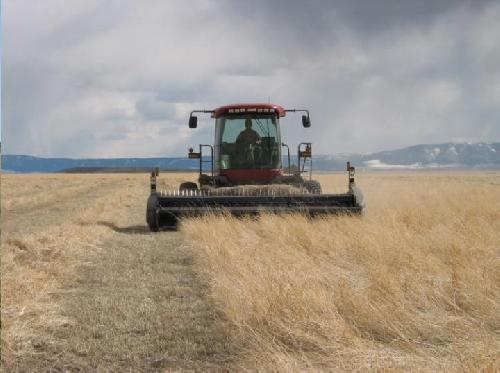URBANA, Ill. - The USDA's Farm Service Agency established the Conservation Reserve Program (CRP) 30 years ago in an effort to improve water quality, reduce soil erosion, and increase habitat for sensitive wildlife species. The program pays rent to farmers in exchange for land to be taken out of row crop production and planted with species that improve environmental quality. Thereafter, the land and its cover crop are to be left essentially untouched for the duration of the 10- to 15-year contract. But what if the biomass from CRP land could be harvested as a source for bioenergy? A team led by University of Illinois researchers set out to determine potential biomass yield and economic benefits of using CRP land to meet government mandates for ethanol production.
"In 2008, we started long term research at the field scale. We wanted to estimate CRP biomass yield and best management practices, including nitrogen application rates and harvest timing, to maximize yield," notes the study's principal investigator, U of I agronomist D.K. Lee.
Along with collaborators, Lee identified CRP study sites in Georgia, Kansas, Missouri, Montana, North Dakota, and Oklahoma. In each 20-acre research site, nitrogen fertilizer was applied to one acre plots at three rates (0, 50, and 100 lbs per acre). Plots were also harvested at two times: at the peak of biomass production, which differed according to the mixture of species planted at each location; and/or at the end of the growing season, after a killing frost.
 Perennial grasses are harvested for biomass on CRP land. Credit: D.K. Lee
Perennial grasses are harvested for biomass on CRP land. Credit: D.K. Lee
Maximum yield reached 3.5 and 6.4 metric tons per hectare (2.5 acres) for warm-season and cool-season grass mixtures, respectively, depending on location, fertilizer application rate, and harvest timing.
"Nitrogen application increased biomass yield," says Lee. "And we don't have to worry as much about nitrogen runoff for perennial CRP crops like we do with row crops. Even if excess nitrogen were applied, it would be held in the system. That's the beauty of perennials."
Despite positive effects of nitrogen fertilizer in the study systems, economic analyses showed that the yield increase did not justify the costs of fertilizer purchase and application. Adding fertilizer increased the total operating costs of biomass harvest up to 225 percent, depending on application rate and location.
"We also learned that precipitation during the growing season was a critical factor, since the study period included the severe drought of 2012," explains Lee. "That result provided evidence that we need long-term studies like this one to really understand yield dynamics."
Although farmers are currently not allowed to harvest biomass from CRP land, the researchers believe that dedicated bioenergy feedstock production could meet the stated goals of the CRP program, particularly if commodity prices increase.
"Right now, commodity prices are low, but we know they will go up again. When that happens, people could make more money by converting CRP land back to row crops. But CRP is highly erodible land and could cause significant water quality issues if converted," cautions Lee. "Alternatively, the government may have to increase rental payments if commodity prices go up, to keep farmers from converting their CRP land."
One scenario offered by the researchers was a 25 percent rental reduction in years when farmers harvest biomass from CRP land, and an allowance to harvest one third of the acreage per year. If this were implemented, the total cost to the government of operating CRP in the six study states could be reduced by $31 million annually.
"Although this scenario would generate only one third of the potential biomass for the developing cellulosic bioenergy industry, it would allow for the utilization of otherwise unharvested lands and likely provide economic benefits for land owners, biomass processors, and the U.S. government, while preserving soil resources."
The article, "Impacts of management practices on bioenergy feedstock yield an economic feasibility on Conservation Reserve Program (CRP) grasslands" was published online in December 2015 by GCB Bioenergy. Lead author Eric Anderson, economist Madhu Khanna, and principal investigator D.K. Lee are from the University of Illinois. Contributors from six other institutions co-authored the paper. Funding was provided by the North Central Regional Sun Grant Center at South Dakota State University through a grant provided by the U.S. Department of Energy Office of Biomass Programs.
source: University of Illinois College of Agricultural, Consumer and Environmental Sciences